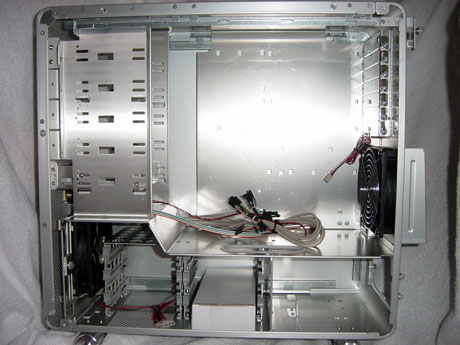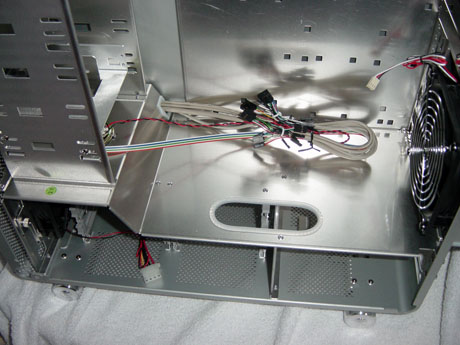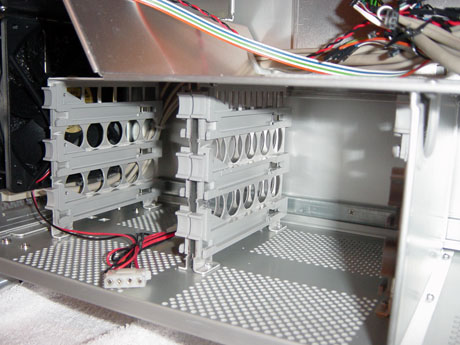Lian Li's PC-V1000: A Case Exclusive
by Purav Sanghani on April 29, 2004 12:05 AM EST- Posted in
- Cases/Cooling/PSUs
Internal Design
Upon removing the right access panel, we found an almost redesigned/redefined ATX style layout. The case is partitioned into 2 sections; the top 2/3 contains the 5-1/4" drive bays on the left (front of case) and the motherboard tray on the right (back of case). The bottom 1/3 section contains the 3-1/2" drive bays on the left and the power supply mounting at the right.The 2 main partitions are separated by an aluminum panel, which has an elliptical cut hole for wiring to pass through. For added protection, the edge of this hole is lined with a plastic guard as shown in the picture. The bottom 1/3 is also separated by an aluminum panel and also has an opening for wiring between the power supply and hard drives.
We found one major problem with the partitioned design and the use of standard flat IDE cables to connect hard drives to the motherboard. The cutout is placed in a way that does not allow the short IDE cables to pass through and reach IDE connections on standard motherboards. Owners of SATA drives won't have such a big problem with this, besides the fact that so many wires, SATA and power, will be running through this rather small opening. Considering that there are 6 bays for 3-1/2" drive applications, SATA is the only logical option, since its data cable is much smaller than standard IDE, and much quicker than round IDE cables.
A feature that we noticed in the PC-V1000 was the tool-less hard drive mounting device. Though it cannot be compared to the drive rail method, it's just as easy to use. To mount a HDD, screw in the included HDD fixed screws onto the HDD (2 on either side) and slide it into one of the six built-in guides.
We were not so lucky to be able to test this feature, since the included screws were of the wrong type; rounded heads and a bit longer than what would fit into the slots. We have contacted Lian Li about this to ensure that the final product will include the correct hardware.
Though the PC-V1000 is not completely tool-less, it does have features that make up for this, and its new design layout made sense to us. For example, placing the hard drive bays as well as the power supply lower in the chassis drops the center of gravity, which helps keep the case from tipping over.













32 Comments
View All Comments
jdepew - Friday, April 30, 2004 - link
Kinda funny that at a site like AnandTech, there was absolutely no reference mde to the G5 (extensvely commented on) or that fact that this isn't some new design for a case but an attempt at an amalgomation between ATX components and the new BTX form factor design.Come on guys --- cover how much it is like a BTX case and what we can expect with the new format!
katka - Thursday, April 29, 2004 - link
$200 is NOT a value, I guess I will wait for the knock offs. :(jiulemoigt - Thursday, April 29, 2004 - link
I t amazes me no one seems to notice you have this nice ventlation then you put a soild block of alumium across where the air should be fowing, evenly through out the case. That is horrible constrution I don't care if it sturdier, as more weight and heat sitting on the most expensive componets is a bad idea in the long run.jiulemoigt - Thursday, April 29, 2004 - link
LtPage1 - Thursday, April 29, 2004 - link
well, it was only a matter of time that someone copied the G5.too bad they made an INCREDIBLY UGLY copy of it. they kept the least attractive part (the cheese-graterishness) and left out everything that makes the g5 great. hmm. sounds a bit like Mac OS and Windows.
madgonad - Thursday, April 29, 2004 - link
I'm amazed at the thermal properties. I guess 10 pounds of aluminum and a porous skin is a good thing. Maybe someone can take a IR pic of one running to see how much heat radiates versus blown out the back.More important is the lack of reset button, and massive traffic jam of cables going through that eliptical plastic hole. If parallel cables are in your future, this case is not for you.
Murst - Thursday, April 29, 2004 - link
This design has to be the worst I've ever seen from Lian Li. Forget the looks (I never really cared about that), but all the holes? That's insane. I have a filter on my fans for a reason. Although I don't smoke in the room that my computer is in (wish I could, but that's not an option), there's a ton of crap in the air still and taking a look at the filter every day proves that. Now, short of having a completely filtered ROOM (don't even bother opening a window), your entire motherboard + perhiprals will get not only dust, but anything under 2mm on them (that happens to be in the air). This just seems absurd.Sure, even with a filter your stuff will eventually get dirty, but nothing like this.
Falloutboy525 - Thursday, April 29, 2004 - link
dang I was hopping the "value" lable on lian li website meant it would cost around 80-150 oh well..... wounder how much the V2000 is going to be thats the on I wantKristopherKubicki - Thursday, April 29, 2004 - link
This case has very little to do with the G5 design. It really doesnt even look like one, particularly on the inside.Kristopher
mkruer - Thursday, April 29, 2004 - link
Four things,First, I still like the design of the PC-60 through P-65 & the PC-70 thorough PC-75 the best.
Second, Why do they neve place all the USB and audio ports on the top or the sides? I don’t know about you but I don’t know about everyone else but I like to keep my desktop klean, and that relegates the floor for the system. Placing the connection on the side or top seems more logical then at the bottom of the case.
Third, I am glad that the PSU is now at the bottom of the case, I have been waiting a long time for that to happen.
Forth, to improve Air flow why don’t they cut out back where the fan is? This would reduce the noise the most. It’s the fan against the cheese grater back that it producing all most of the turbulence in the air, hence the noise. There is also lese resistance. For the air flow.